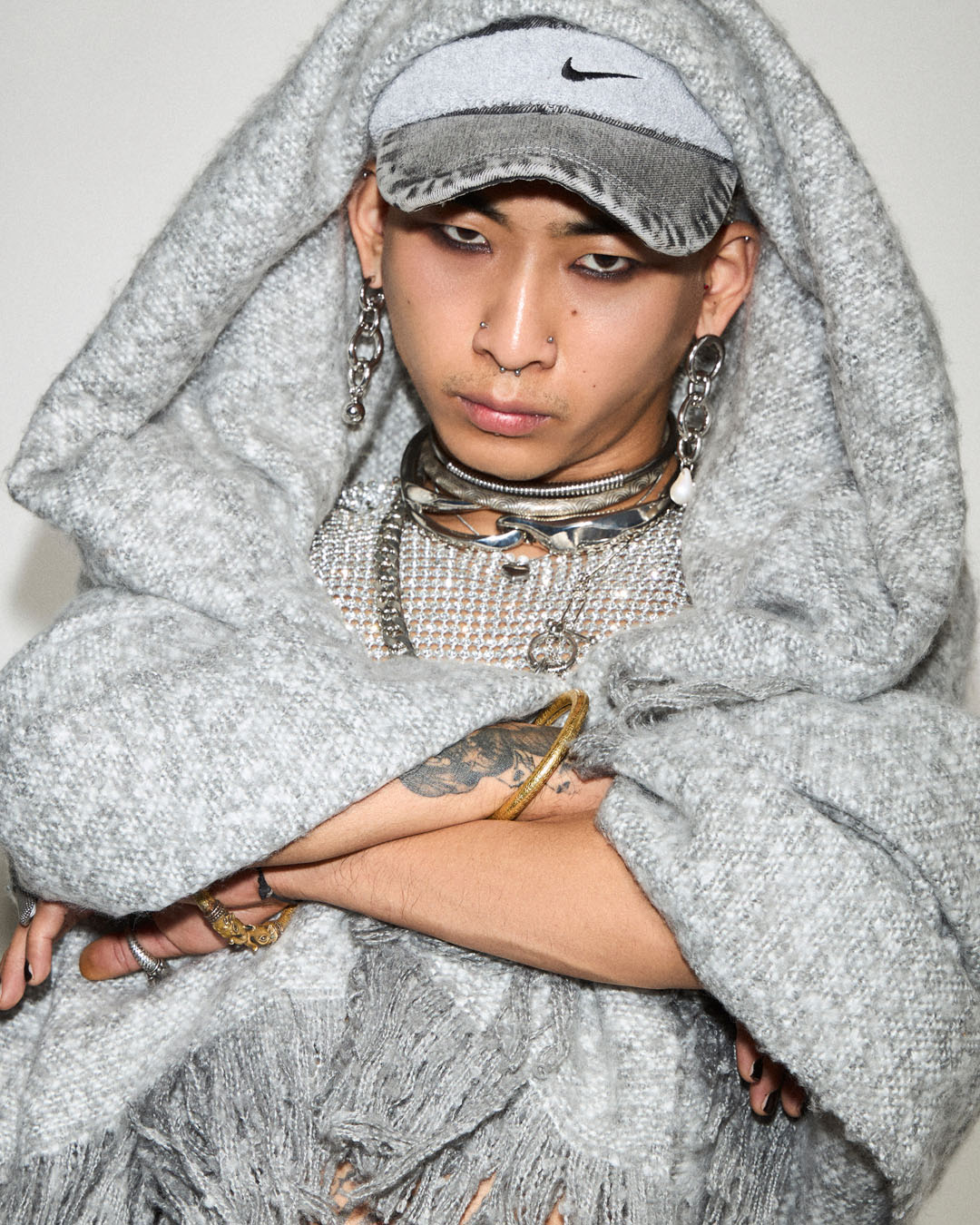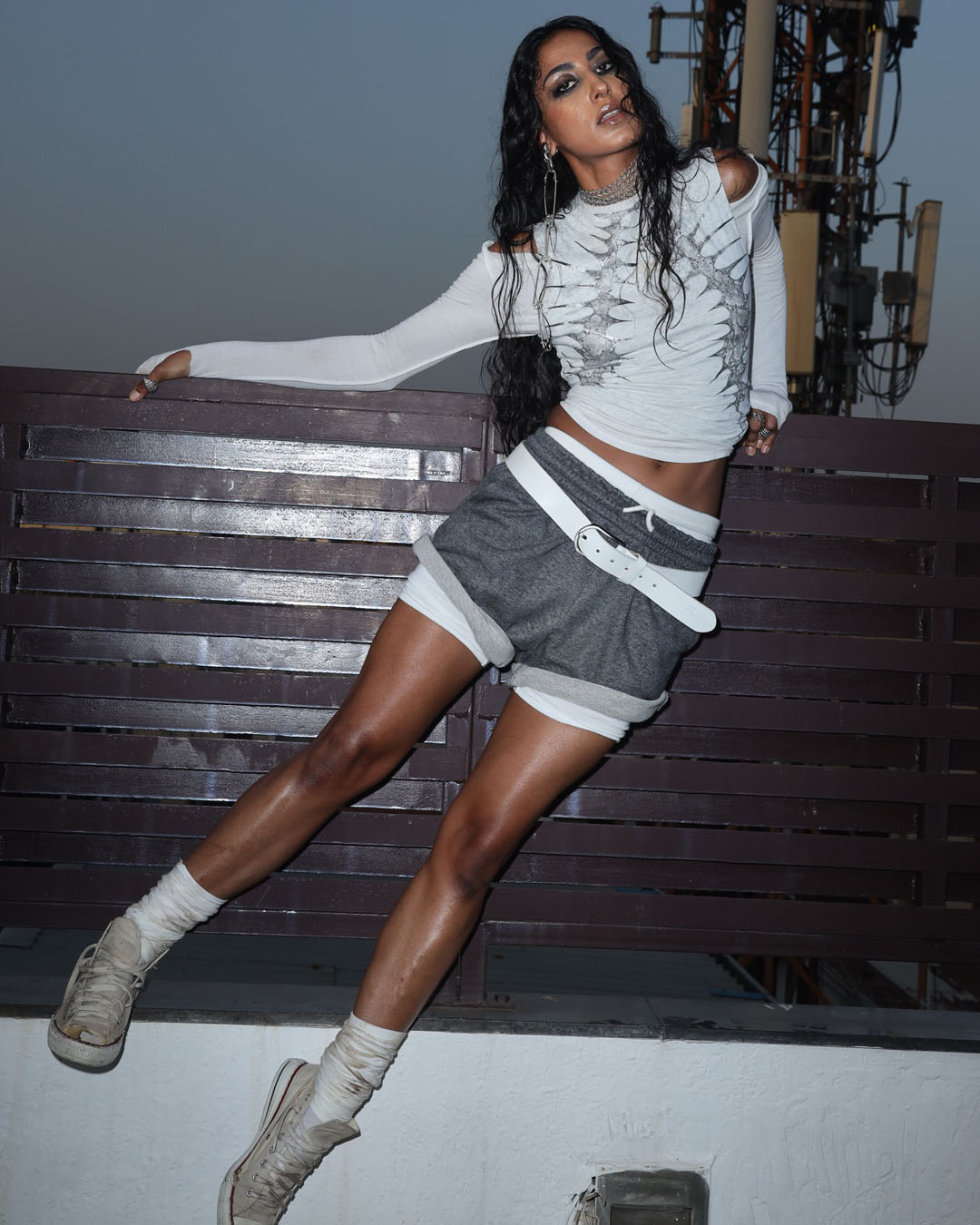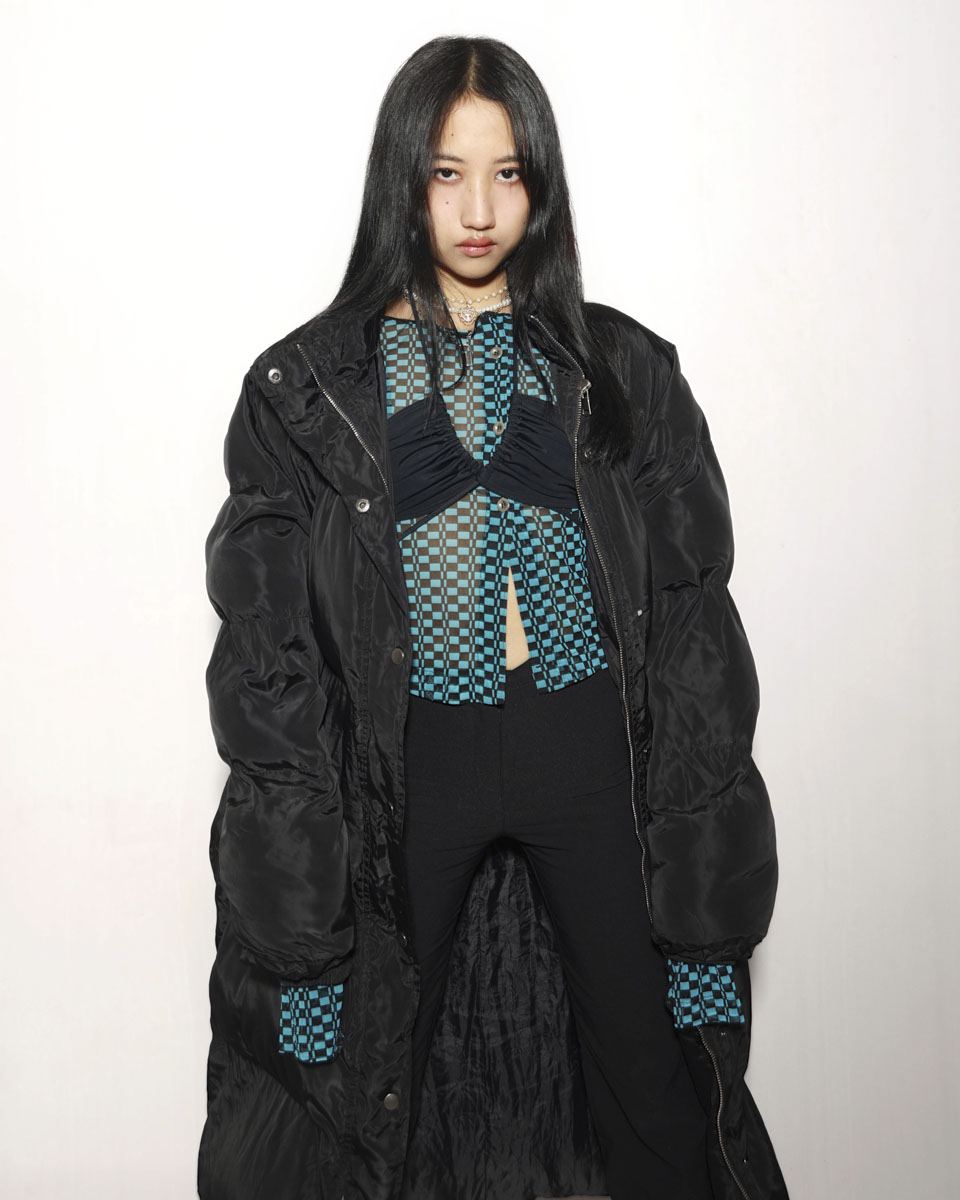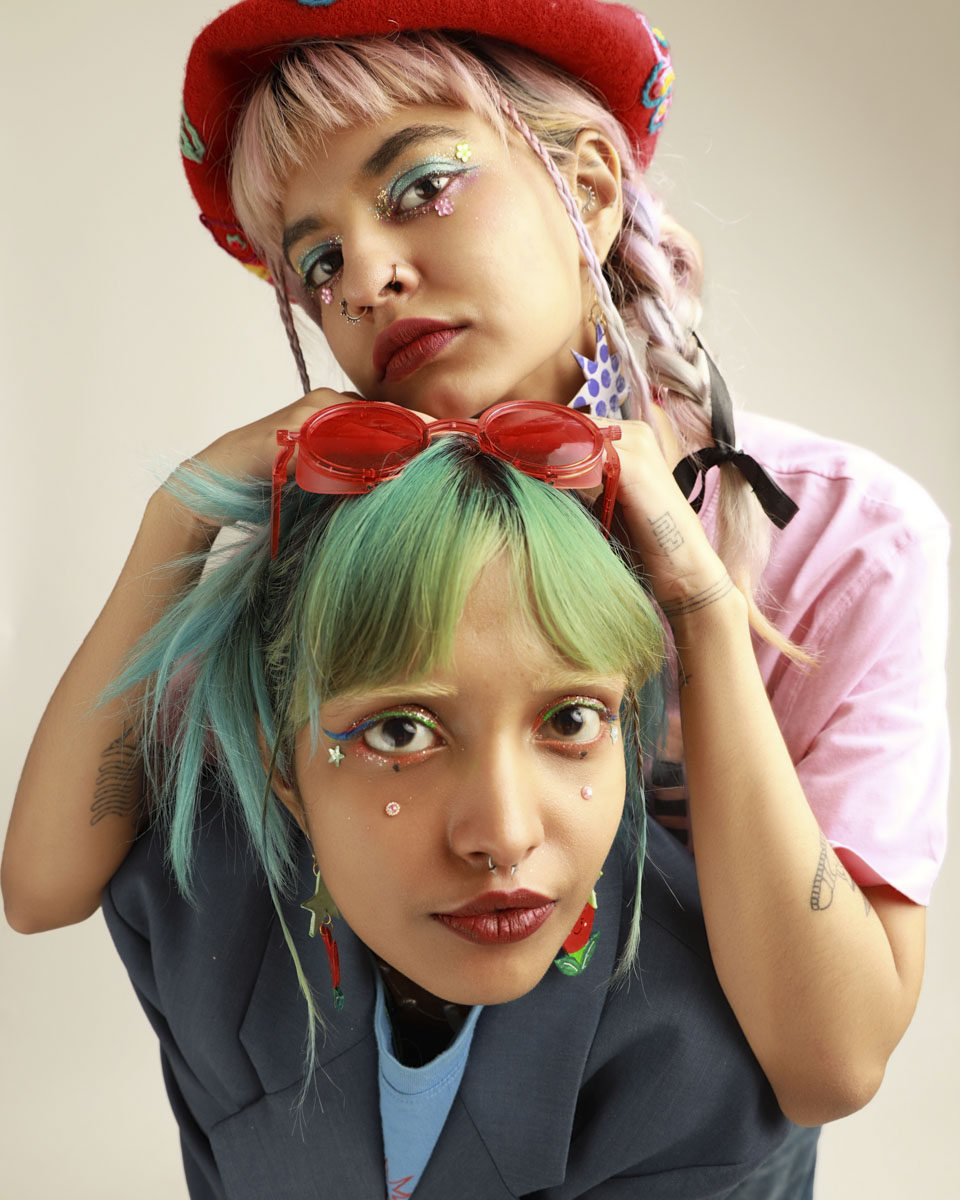We gave fashion design students and aspiring designers the chance to ask questions to these inspiring fashion designers. Here are our top 25 pick…
Photography: Runvijay Paul Hair and Make up: Radhika Khunteta
HOW OLD IS THE BRAND
Abhishek Paatni for NoughtOne: My brand is almost three years old. NoughtOne was started by me and my partner, Ankur Sharma with the vision of making a menswear only brand.
Dhruv Kapoor for Dhruv Kapoor: The brand was founded in 2013 once I returned to India after completing my masters at Istituto Marangoni. The brand lays its foundation on blending extremes such as masculine and feminine, minimal and excess, vulgar and conservative, always retaining wearability, keeping a sense of detachment and focusing on the new revolution.
Nitin Chawla for Theorem: Theorem started in August 2013, debuted in the Gennext category at the coveted Lakme India Fashion Week, Mumbai. It has been almost three years, but we still feel that we have just started and there’s lot to be done.
Pranav Mishra and Shyma Shetty for HUEMN: HUEMN is five years old. The growth of the brand has been very organic till now.
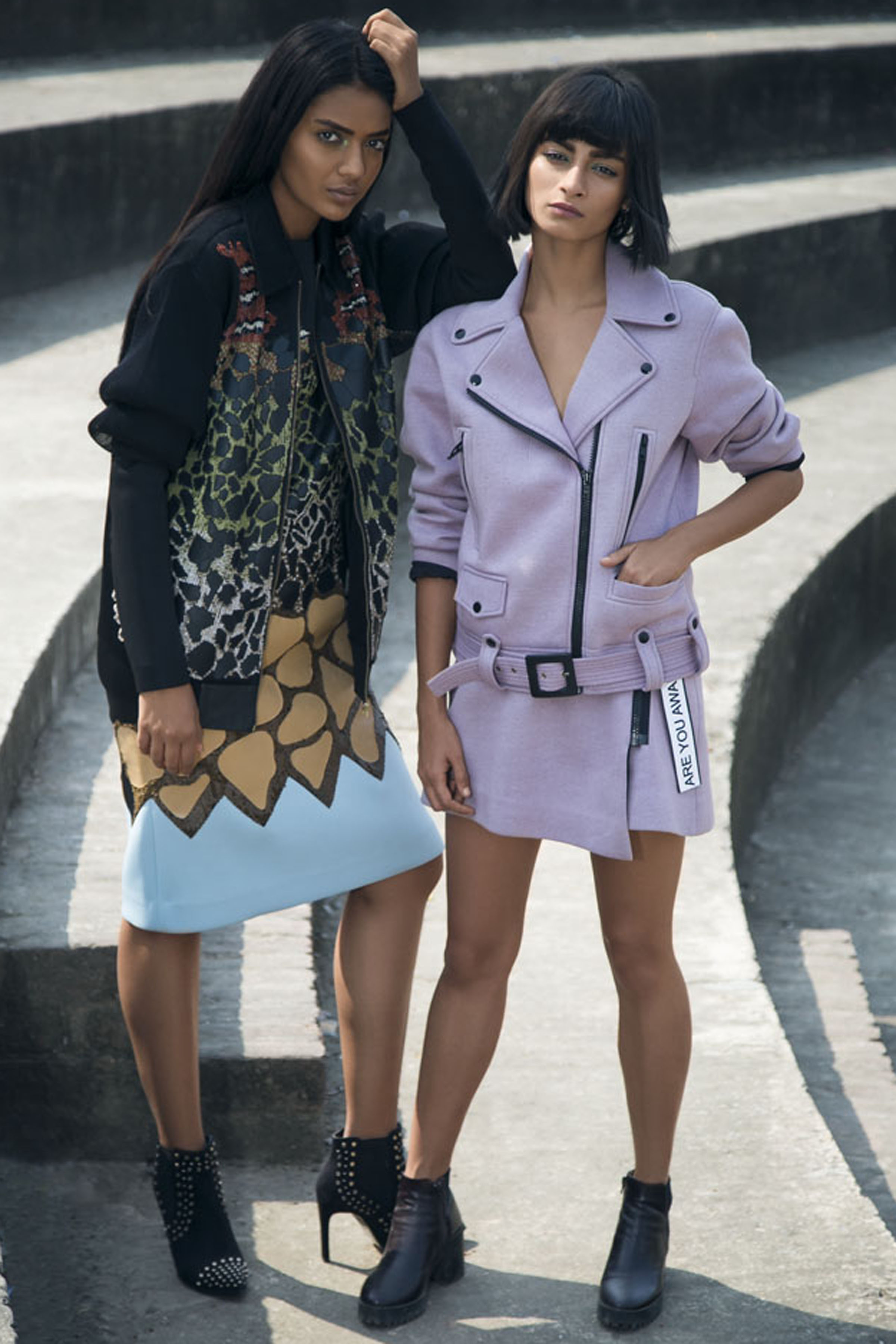
(L-R)
On Palak: Dress, jacket, HUEMN
On Rodali: Skirt, Jacket, DHRUV KAPOOR
IF YOU HAD A CELEBRITY BRAND AMBASSADOR, WHO WOULD IT BE
A: Pharrell Williams, he is effortless and makes great music.
D: It would be a really decisive “WOMAN”. Naming one person limits the scope of the brand. We project new femininity and try to tap the powerhouse within each one of them.
N: Renzo Rosso, the jeans genius as everyone knows him. Because of his core philosophy of “Being Stupid “which actually revolutionized the global fashion industry at one point in time.
P: At the moment we are not thinking in that direction, even hypothetically.
WHAT ARE THE TOP THREE CHALLENGES INDIAN DESIGNERS MAKING NON-TRADITIONAL CLOTHES FACE
A: I think the most crucial challenge is to find the end consumers for such an aesthetic in India.
D: ACCEPTANCE, EXPERIMENTATION and CONSIGNMENT. The Indian market is definitely exploring new directions in fashion and self-expression. It is at a really slow pace, but it is there. Consignment is our biggest issue. I personally feel that the stores need to be more aggressive with the image of the modern woman and take the risk of buying the collections as a support to the designer. On consignment, what sells are the traditional Indian clothes. Western wear isn’t pushed enough. The buyers need to be well informed about the new femininity most of the younger brands are targeting rather than focusing on pure wedding aesthetic.
N: The first challenge is the pricing/costing. People start comparing our prices with other high street retail brands. Our prices would be high because of a simple fact that our cost of production is comparatively very high due to a limited number of pieces we produce. Other high street retailers produce or source their productions in huge quantities ranging in thousands or even lacs of pieces. Their per unit cost, hence, is very low. For example, the same fabric that costs us, say Rs 1800 would only cost them Rs 150. Our making/construction cost would be, for example, say Rs 1000 and theirs only Rs 200. My job experience of almost 8 years with Export Houses, before starting my own venture, is the source of this insightful information. Secondly, these high street retailers have huge marketing budgets and they create a “Symbolic brand image”, which is not feasible for us until and unless we find a partner to take care of all these marketing strategies. Lastly, in India, people spend more on wedding clothes and occasion wear rather than spending on day wear.
P: It was quite tough to come to the stage where we are now. There are so many challenges right from setting up your unit with limited resources, finding your clients, and at the same time having your unique voice. You have to keep understanding people’s taste. When we entered the industry we had a very limited idea of how the industry functions. One of the ways to survive and grow is to be determined and stubborn for your work. Obviously, it takes time, and it should take time. The challenges teach you on the way. For example, about the taste of consumers. At the end of the day, we are service people and not artists. We provide service in terms of a better fit, choice, etc. Whatever goes in our mind may not matter if the customer wearing your brand does not like it. It becomes even more difficult if you have limited supply of resources and have to take each step cautiously and at the same time maintain the quality. You have to expand step by step. You cannot hold a big team from the day one. This is only possible if you understand the basic principle of the business that the amount that you want to invest out of the bank account has to come in first. To summarize, the main challenge is about money supply and how to get the money in before you let it out for expansion. This is made even more challenging since the Indian market is not very transparent. People talk about sustainability, but if you do not pay on time, it does not make much sense. Even if your product is great, and even if you are able to crack the business side of it. It is a challenge to get payments from buyers. At times there are payment delays of up to 6-8 months.! The younger your brand is, the more exploited you get. The irony is that no one talks about it. But then, the deal is to come out of it and make people work on your terms and that can happen only if you build customer loyalty and customer come to you for your product.
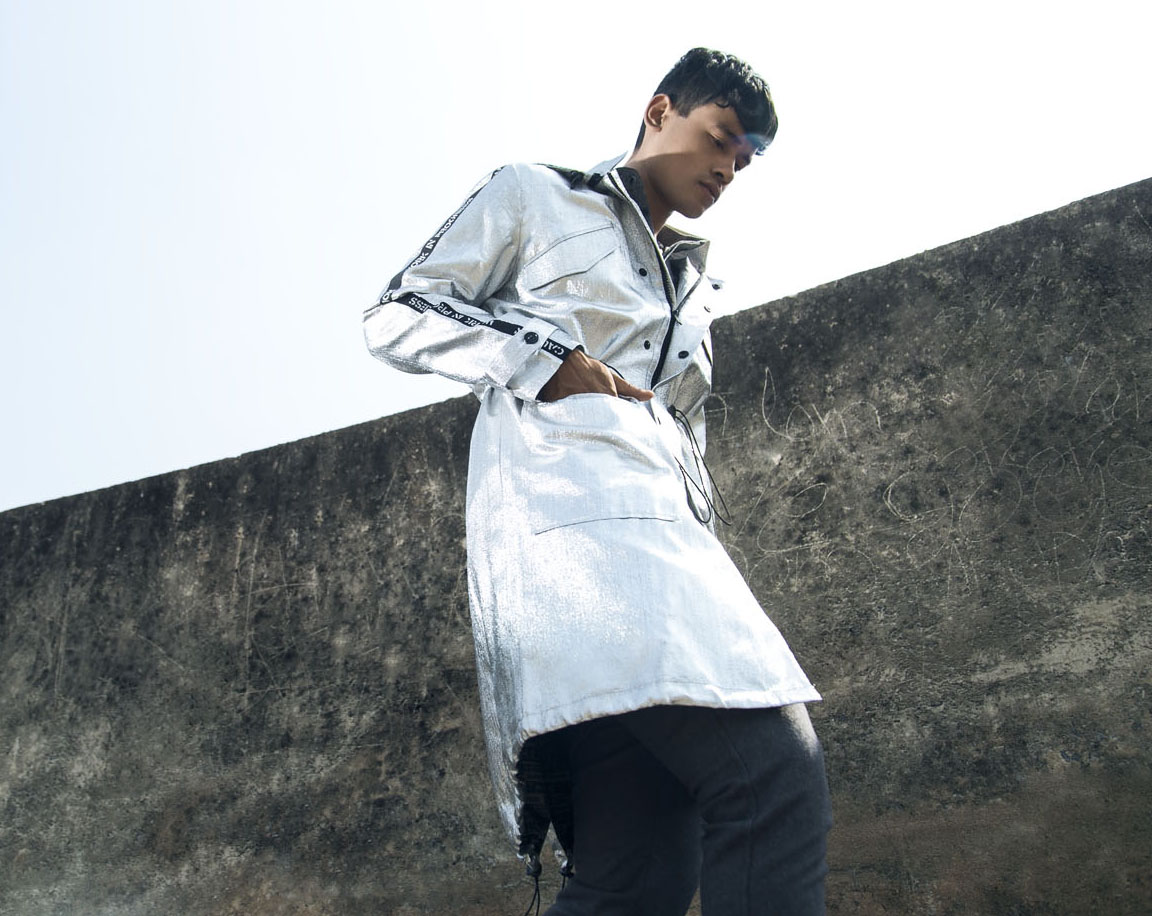
On Siddharth: Jacket, trousers, Theorem
WHAT ARE THE ADVANTAGES YOUR BRAND HAS COMPARED TO OTHER OPTIONS THAT ARE AVAILABLE TO US
A: I consider my brand as street luxury and not western wear. It’s really important to have a clear definition of who you are and how you want to be perceived as. NoughtOne offers products based on a physiographic analysis rather than demographic, ergo with adequate feedback from the consumers, we are able to provide more desirable products than others (to the Indian consumer).
D: FABRIC. We develop most of our key fabrics every season. One can easily mistake it for a neoprene but it’s not. The eclectic mix of fabric would be from South Korea, Italy and India of course. Other than the fabric, it would be our bold usage of embroidery, print and color.
N: Theorem emphasises on strong pattern making which goes unnoticed at times and a lot of research and development is done on the fabrics, the best part being that this research and development is done using the local sources as per the availability and at times due to the budget constraints we have. So it is like using the available resources in the best possible manner. Also, Theorem offers a mix of luxury and athleisure.
S: I definitely wouldn’t use term ‘advantage’ but I’ll just talk about our product. There’s a lot of thought that goes into creating garments that provoke thought and inspire conversation. We have some great stories behind each idea, but at HUEMN, the end product is the king. It is as exciting as an idea as impeccable it is in craftsmanship. We make separates that are affordable with the most premium fabrics and finishes. We try to evolve rapidly with the times and keep the product super fresh so that it is constantly relevant.
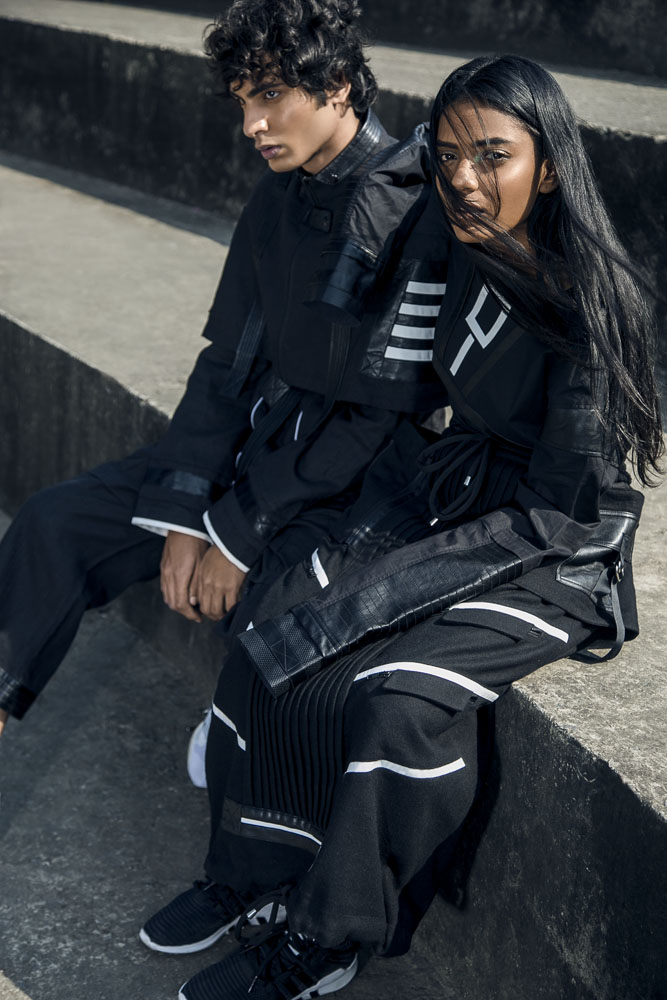
ONE THING YOU WISHED CHANGED ABOUT FASHION WEEKS IN INDIA
A: More menswear shows, or maybe a menswear day!
D: That background full of sponsors! The designer should have the leverage of building the space that is in sync with the collection, a more exciting seating plan and something off the basic. Also, “ONE” fashion week for the country would be perfect.
N: More collaborations of established brands say Nike, Adidas, etc with emerging talents which benefit both sides.
S: I wish Fashion Week in India was scheduled earlier than it is so that we could release our collections much earlier and have a real chance of projecting our global forecasts. The idea of the new seasons’ work being extraordinarily fresh and heralding change is exciting to me.
Another thing I wish for is tighter fashion journalism with genuine critique.
WHEN Making YOUR COLLECTION, WHO DO YOU KEEP IN MIND? INDIAN OR INTERNATIONAL CLIENTS
A: When I design for NoughtOne, I design keeping in mind a global psyche and not the demographic. For me it’s a holistic approach and allows me a global exposure in terms of the market place.
D: We are focused on pushing the new aesthetics of the modern woman. Location is restrictive. Once we are in discussions with buyers we tweak according to their market. But the brand works on global appeal.
N: While working on my collections, the overall appeal is sort of global with no boundaries. But later, we take elements from the same collection and work it out as per the demographics.
P: The gap between the specific demands of different customers is filling up because of the transparency we now have due to internet and availability of information. It’s not black and white anymore. Obviously, the shapes and sizes of different geographic areas vary, but the styles are more or less blending and only depends on the season that you are catering to. We follow a unique style that caters to a very global market. We don’t think of cultural orientation of the clients, rather customer satisfaction is a more important factor.
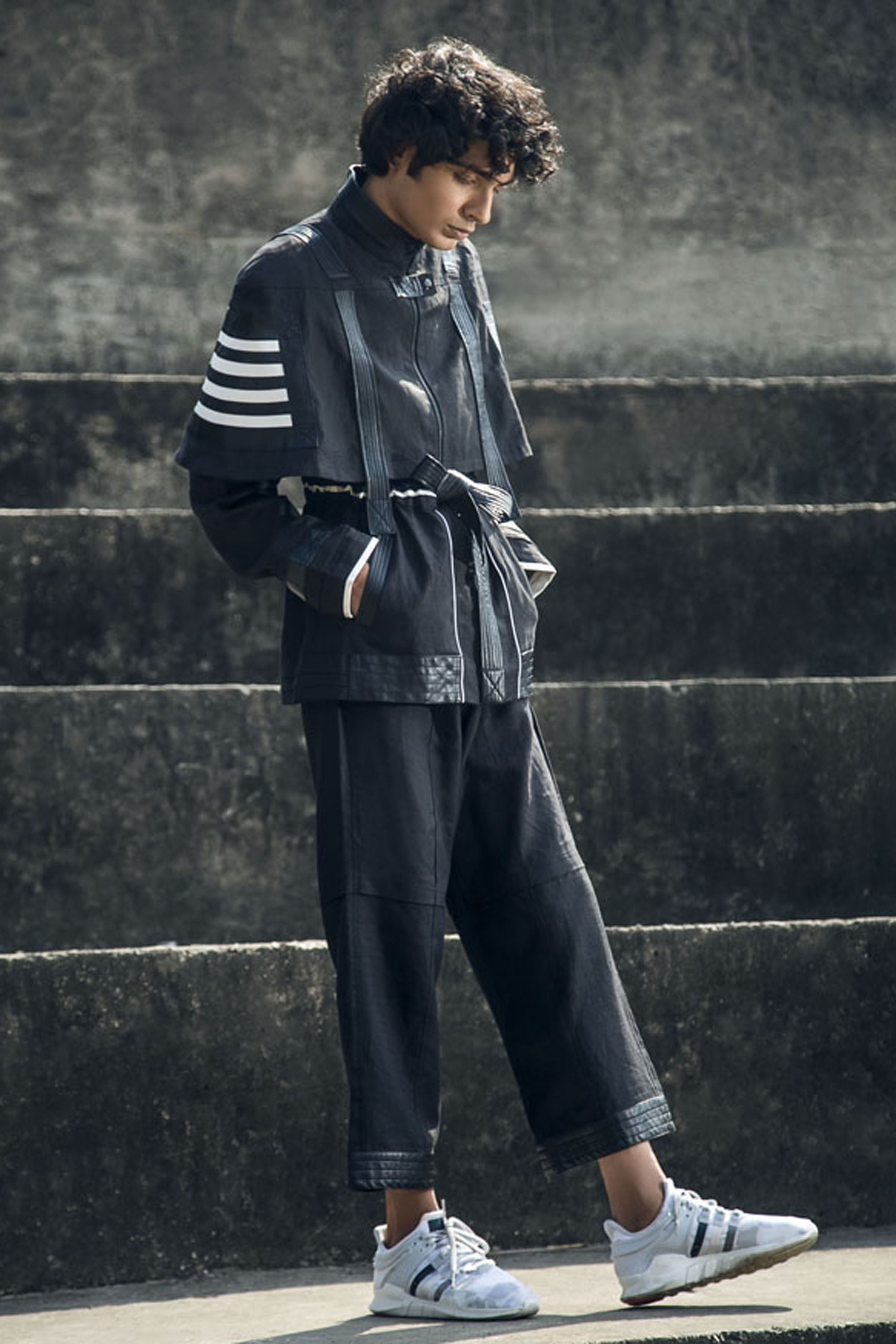
On TJ: Jacket, trousers, NoughtOne; Shoes, EQT by Adidas Originals
HOW IS THE RESPONSE FROM INTERNATIONAL BUYERS, CONSIDERING THE MANY OPTIONS THEY ALREADY HAVE IN WESTERN WEAR
A: I am still in the process of figuring out the international markets for my brand. I do believe that people buy Indian products for its unique craft and quality. Having said that, I believe that a good quality product can come out from any part of the world and would sooner or later be picked up by a fashion enthusiast or consumer without looking at the origin of the brand.
D: The international market was extremely receptive. We have always received a fabulous response. It’s the image. The aesthetic is already prevailing internationally and they are in sync. Obviously the craftsmanship at a lower price is an added bonus but never their focus.
N: We are still a work in progress as far as the International market is concerned and a lot has to be done to excel in the same. Although we have been making smaller quantities for the international clients and overall it’s a good thing for the brand as it creates a global outreach, but one has to make sure that the finishing, quality assurances are up to the mark. The reason they choose any nontraditional brand is a matter of choice which they make, it can be both, pricing or innovation
P: We can argue about the definition of western wear and traditional wear. We don’t want to classify our product as western wear. We would rather say ready-to-wear. When you are making ready-to-wear, it is a big market globally and India is as much part of it as any other country.
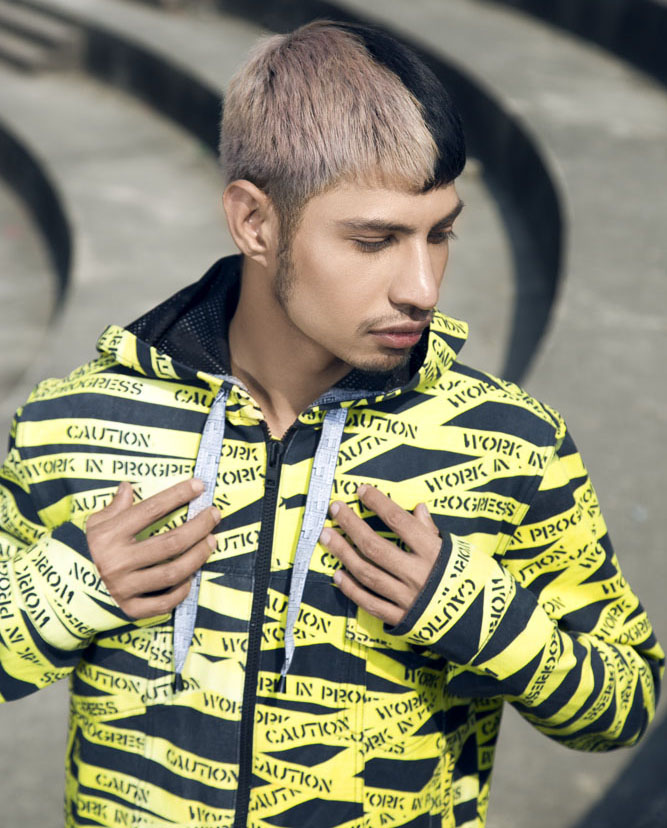
On Sherwin: Jacket, Theorem
WHO IS YOUR BIGGEST COMPETITOR
A:It’s too soon to comment on the competitors considering our company size and reach. In the next five years, we would like to be stocked at stores along the likes of Public School and Neil Barett.
D: I look up to some brands but definitely not in a competing spirit. I rather learn from them. We each have our own story to tell.
N: Till now I have never thought of them to be my competitors as we are a work in progress. But I really like Stone Island, G-Star, Firetrap, John Varvatos, White Mountaineering, Moncler, Thom Browne, Coach, Raf Simons, the list is endless…
P: All the brands that are doing well globally are the competitors since you always want to be in competition with the best. There are so many brands that are doing such brilliant work for the past 80-90 years and are still growing. That’s the kind of competition we look forward to. I can’t think of a specific brand that I can pin point.
WHAT STEPS CAN EACH ONE OF US TAKE TO HELP CREATE AN ENVIRONMENT THAT SUPPORTS NEW TALENT. ESPECIALLY THE ONES WHO ARE INTO NONTRADITIONAL DESIGNS
A: I think it’s very important to discover and support new talents. Also, to appreciate more through sales than only words.
D: It all comes down to authenticity and being true to who you are. We need to project fearlessness, they need to know that they are free to be who they are without judgment.
N: A lot of times a particular stereotype about an emerging talent makes or breaks them. It is a fact that cannot be denied. And words do prove beneficial in sales as well. So, if emerging talents can be encouraged and supported in a way then that would really inspire them to work fearlessly. It would help them grow.
S: There is no need to encourage future designers to make ‘western’ wear. These terms are too black and white and restrictive. Fashion has always been the best representation of the times we have lived in and will always be a reflection of our lives. As new generations have been ushered in and our lifestyles have changed as the world opened up, garments steeped in cultural identity have already become occasion wear. The key to fashion is relevance. The experiences that surround us today are global conversations and are not restricted to our little towns and cities. The voice that speaks out today has to be globally relevant. What you wear and how you conduct yourself has to be globally relevant. Our lives and businesses have opened up to a worldwide audience, and ‘now’ and ‘tomorrow’ are more meaningful than ever, considering we are on the brink of a global environment crisis. Yes, designers need to be more fearless in their vision but that also needs to be facilitated by buyers that invest in that vision and media that ushers in the change.
WHAT IS THE INTERNATIONAL MARKET DOING THAT WE ARE NOT
A: We need to develop more respect for the local craft and the best way to go about it would be to buy.
D: Internationally, the higher ups are more involved in pushing young design talent. Vogue Fashion Fund is one such initiative. There need to be many more of these, backed by industrialists to uplift talent from our country.
N: At the international front, initiatives are being taken to support emerging talents (financial support as well as mentorship by the best of the industry insiders). Also, the industry experts at times directly collaborate or tie up with the emerging talents which result in nurturing the younger ones. I guess such initiatives would really help upcoming and good designers before they give up or get lost.
S: Working in an environment that facilitates rapid merit based growth in a fashion business.
WHICH INDIAN DESIGNER INSPIRES YOU
A: HUEMN’s Pranav and Shyma. They are original and have an unadulterated raw aesthetic.
D: Sabyasachi! I admire the genius in him.
N: Rajesh Pratap Singh.
P: There are so many. I cannot pin point. There are some who inspire by the way they dress up, some by the way they talk, some by their business strategy and others by their designs. For example, the way Tarun Tahiliani talks in his interviews is beautiful. The way some new kids dress up is inspiring. The business strategy of Anita Dongre is very good. The way Sabyasachi Mukherjee has established the brand in such a short span is commendable.
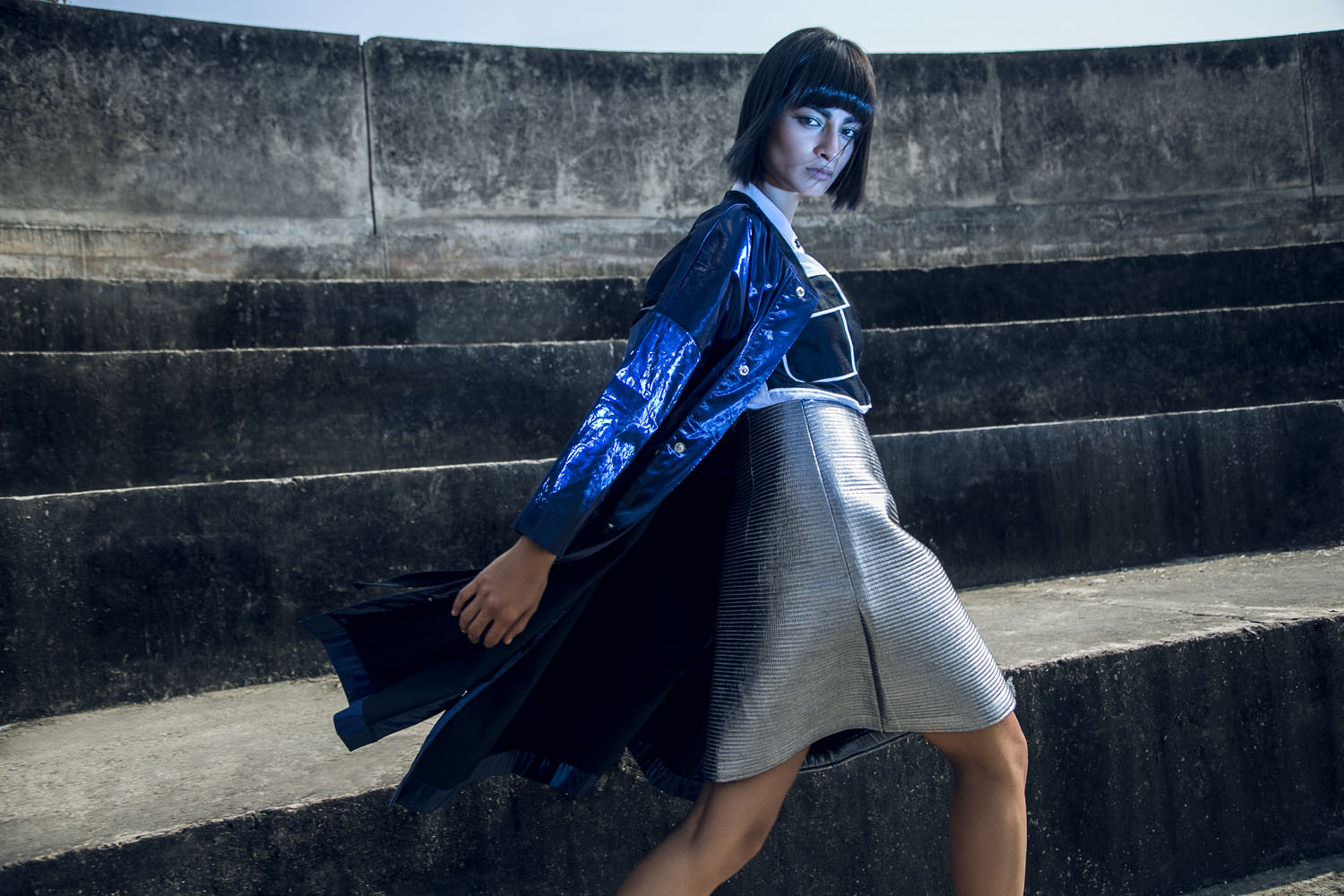
On Rodali: Jacket, skirt, T-shirt, DHRUV KAPOOR
HOW IMPORTANT IS RETAIL SPACE IN THE CURRENT TIMES OF E-COMMERCE
A: It is necessary for a brand to sell directly to its consumers and get feedback as well. A retail space should be well planned and well funded. Always remember that the experience that clients take back, makes or breaks a brand.
D: The most important!
It’s an experience! One must work hard to deliver the best possible experience to their clients. However, there is a lack of innovation. Designers here would never invest with Frank Gehry, to build their space. Something fresh, experimental and out there, something in sync with the image of the brand! I am bored of the basic gold and floral spaces.
N: Retail space is extremely important. A brand having their own flagship store adds to the brand’s growth prospects. One of the challenges is getting retail space at the right location and the finances for the same.
P: It is always a great idea. And I know few of my friends from the fashion fraternity who are doing great business from their retail channels. It leads to a good recall value for the customers. You are also able to develop your own database to build on. However, all of it is assuming that you are providing good value to your customers in the first place. It is even more important since the customers make so much effort to come to the store considering there are multiple and more convenient alternatives.
WHAT DO YOU KNOW NOW THAT YOU WISH YOU KNEW WHEN STARTING OUT
A: Contacts of all the multi brand retail stores and fabric vendors. It would have saved a lot of time.
D: I love learning along the way. If it was all given before starting out, it would be a boring process.
N: I guess there is no such thing, as everything happens for all the right reasons, one learns from all the experiences.
P: The market is screwed up! If we were as clear about it before as we are now, we would have been better off. Probably, instead of taking five years to be at the place we are now, we may have taken 3.5 years instead. But, then where ever there is crisis, there is opportunity. Having said that, there is a reason it is easier to start a brand here compared to any other part of the world. It is not easy to be an entrepreneur, or to be a designer in USA. Even though there are challenges, the opportunities in India are significant.
WHAT do YOU LOOK FOR IN AN EMPLOYEE
A: Originality and madness.
D: Authenticity, fearlessness and FOCUS.
N: Patience.
P: All members of the team have to be on their toes. Even one minute cannot be wasted. It is encouraging to see people who take initiative, rather than wait for instructions all the time.
FOR OUR READERS, WHERE CAN WE BUY THE BRAND
A: www.noughtone.in has more details, you can also email us at noughtone@outlook.com.
D: Our showroom in Gurgaon, though it is by appointment only, or Le Mill in Mumbai.
N: The brand is available at Aza, Aura, Almari and a few online stores. We can also be contacted directly for sale enquiries at: theorembynitinchawla@gmail.com.
P: Pernia’s Pop-Up Shop is one of the key channels, among other online stores. Physically, there are multiple stores in Delhi, Mumbai, Chennai, Nagpur, Kolkata, Raipur, etc. from where the brand could be bought.
WHAT DO WE NOT KNOW ABOUT YOUR BRAND THAT YOU WOULD LIKE TO TELL US
A: We would drop some womenswear very soon!
D: I am going to hold on to this one. Let’s unveil step by step. I am sure you would like it.
N: “Story telling & Expression” are the two tools of our design philosophy, that gives greater meaning and interest to the products beyond the pure utilitarian and adornment purposes, keeping in mind today’s modern sensibilities. Theorem portrays that our subconscious mind has the ability to let deeper thoughts lying in the mind’s fold resurface to the fore and contemplate about them in “Detail”. Our designs are an outcome of this self explained “Theorem “. Essential Practicality, Meticulous attention to detail and sharp Tailoring are the key features of the garments.
P: Transparency is a significant part of our business process. Information about us is readily available.


